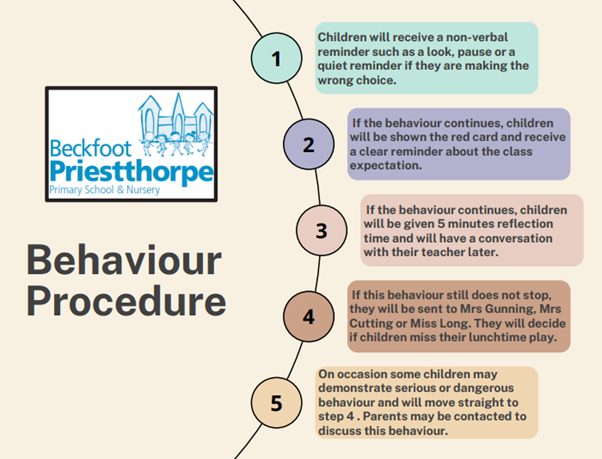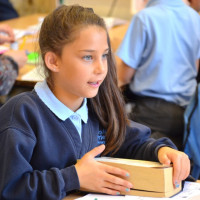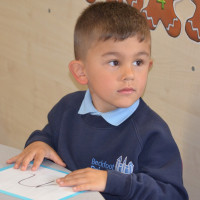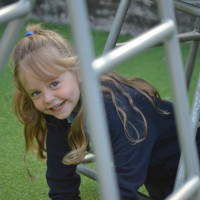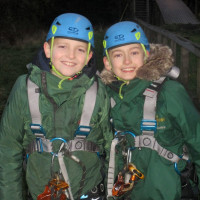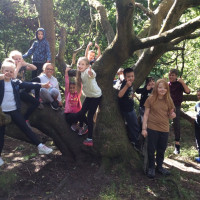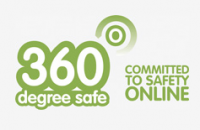Behaviour
"Most pupils behave well. They are courteous and polite towards each other, and adults. Pupils respond positively to the high expectations that adults have of them. Pupils feel that the school is a safe place to be. They understand what bullying is. Bullying is rare and always gets dealt with appropriately by adults"
Ofsted June 2023
Our goal is to have a behaviour policy that prevents poor behaviour before it begins. There are consequences for unacceptable behaviour, but we believe that if we have positive relationships with children, a stimulating learning environment, a high quality curriculum and set high expectations then there will be fewer behavioural incidents. Our policy sets out approaches that will lead to good or better behaviour if they are followed daily and consistently. If a child hurts another using words or actions they are moved immediately to red and receive a suitable consequence.
Anti Bullying
At Beckfoot Priestthorpe Primary & Nursery School we are determined to provide our pupils with a safe, secure and happy environment in which to learn. We expect high standards of behaviour and do our best to encourage our pupils to develop into responsible and valued members of the community.
What is bullying?
Bullying is:
- deliberately hurtful behaviour,
- repeated often over a period of time,
- difficult for those being bullied to defend themselves against.
It usually takes one of four forms:
- Physical e.g. hitting, fighting, taking belongings
- Verbal e.g. name-calling, insulting remarks, racist comments
- Indirect e.g. rumour-mongering, excluding someone from social groups
- Cyber-bullying e.g. texting, use of websites etc
This type of behaviour is contrary to the ethos of our school. In partnership with parents, we aim to raise awareness and prevent such behaviour.
Behaviour Protocol Beckfoot Priestthorpe
Quality first Teaching including use of the Behaviour Checklist is the pre-requisite for supporting all children.
Our aim is for ALL children to be Great Priestthorpe Learners. When necessary, this guide should allow for a quick return to highly successful learning.
Use the recognition board at every opportunity to mark going over and above and PRAISE IN PUBLIC
The final decision for how to respond to breaches of the behaviour policy rests with the headteacher. The headteacher retains the right to use discretion as and when required and these decisions will not be discussed with other parents.
Difficult behaviour is defined as:
- Not following Priestthorpe Routines
- Disruption in lessons, in corridors and at break and lunchtimes
- Refusal to respond or engage (refusal to follow reasonable instruction)
- Non-completion of classwork
- Poor attitude to learning – not on task.
Actions for difficult behaviour:
- Clear warning using red card on lanyard and a quiet look or say their name quietly at their side so as not to draw attention to them
- Clear verbal warning using a calm, quiet tone as privately as possible
- (Name. I have noticed… That’s red behaviour because… I need you to…Thank you) and move child to quiet space in classroom if required
(Name. I have noticed you are continuing to… That’s still red behaviour. I need you to…Thank you)
- Move child to another class (escorted) for up to 5 minutes, use sand time or digital timer (Name. I have noticed you are continuing to… That’s still red behaviour. I need you to… Thank you) behaviour recorded in class book by class teacher ASAP in case it escalates further.
- Child returns to class
- If red behaviour continues after time out of classroom, then send a child to the office to ask for a senior member of staff for red behaviour. Behaviour recorded on CPOMS, and detention given for the day after if lunch/break have already happened by SLT.
Actions for Dangerous/Serious/Red behaviour: Always results in a detention or more serious sanction
Red behaviour is defined as:
- Any form of bullying including online bullying
- Unkind words that cause shame
- Verbal abuse including swearing
- Physical aggression including fighting, kicking
- Destructive behaviour, damage, and vandalism
- Racist, sexist, homophobic or discriminatory behaviour
- Sexual bullying, harassment, abuse, or assault
- Any unwanted sexual behaviour that causes humiliation, pain, fear, or intimidation, including online behaviour
- Theft
- Fighting
- Smoking or vaping
- Possession of any prohibited item.
Reasonable Adjustments - A child with SEND Support may be considered for reasonable adjustments to help them succeed. This will be agreed with the SENDCo and SLT in consultation with the staff who work with the child and recorded on their Passport
A very small number of our pupils may need a more bespoke and targeted package to support good learning behaviour in school.
Children with reasonable adjustments are entitled to have all the following strategies in place through their Passport:
- Individual Support Plan for SEMH (Social Emotional Mental Health)
- ‘Pupil drop-ins’ strategy (trusted adult who will check-in with the pupil)
- A meeting with the pupil’s family
- Weekly phone call from the class teacher to home
- Visual timetable (if appropriate)
- Positive handling plan (if appropriate)
- Pupil trained in how to take a sensory circuit break (if appropriate)
Follow up from Difficult/Red Behaviour
- Any movement to another classroom is to be recorded in the class book
- Weekly monitoring by SLT to spot patterns (day of week, time of day, families, etc)
- Concerns discussed at weekly SLT meeting.
